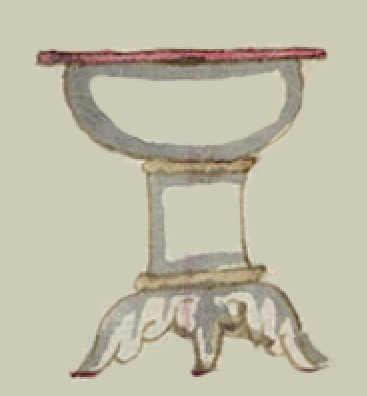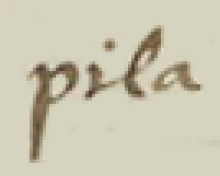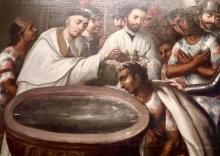pila (CST17)
This painting of the simplex glyph for the term pila (baptismal font, in this case) shows a frontal view of a carved stone basin on a pedestal with an ornate base. The font is white with gray shading, two horizontal tan junctions, and a flat red top, perhaps made of wood.
Stephanie Wood
The companion text states that this baptismal font was made by a carpenter from Mexico City, referred to as a “mexicuatl” [sic] cuauhxinqui. He received 10 pesos. For more on the Codex Sierra, see Kevin Terraciano’s study (2021), 111, 147. A market fountain would be much more expensive than this baptismal font. Granted, it was more than a century later, but a market fountain cost 1,040 pesos, as noted in one of the attestations for pila in our Online Nahuatl Dictionary. See glyphs for two such market fountains below.
Stephanie Wood
1550–1564
Jeff Haskett-Wood
bautismos, bautismo, baptism, pilas, fuentes, religión cristiana
This detail from an eighteenth-century oil painting, “El bautizo de un noble indígena,” signed by José Vivar y Valderrama, shows a memory of a baptismal scene from the era of the Spanish invasion. The scene includes various indigenous nobles, the Mercedarian friar, Bartolomé de Olmedo, Juan Díaz (a member of the clergy), and Hernando Cortés. The one being baptized has been presumed to be Ixtlilxochitl or Cuauhtemoc, but no one knows. Museo Nacional de Historia, Chapultepec Park, Mexico City. Photo by S. Wood, 29 April 2025.

pila, baptismal font or public fountain, https://nahuatl.wired-humanities.org/content/pila
pila
Stephanie Wood
Códice Sierra-Texupan, plate 17, page dated 1558. Origin: Santa Catalina Texupan, Mixteca Alta, State of Oaxaca. Kevin Terraciano has published an outstanding study of this manuscript (Codex Sierra, 2021), and in his book he refers to alphabetic and “pictorial” writing, not hieroglyphic writing. We are still counting some of the imagery from this source as hieroglyphic writing, but we are also including examples of “iconography” where the images verge on European style illustrations or scenes showing activities. We have this iconography category so that such images can be fruitfully compared with hieroglyphs. Hieroglyphic writing was evolving as a result of the influence of European illustrations, and even alphabetic writing impacted it.
https://bidilaf.buap.mx/objeto.xql?id=48281&busqueda=Texupan&action=sear...
The Biblioteca Digital Lafragua of the Biblioteca Histórica José María Lafragua in Puebla, Mexico, publishes this Códice Sierra-Texupan, 1550–1564 (62pp., 30.7 x 21.8 cm.), referring to it as being in the “Public Domain.” This image is published here under a Creative Commons license, asking that you cite the Biblioteca Digital Lafragua and this Visual Lexicon of Aztec Hieroglyphs.




